How to Implement Time-Saving Meeting Hacks for Busy Professionals
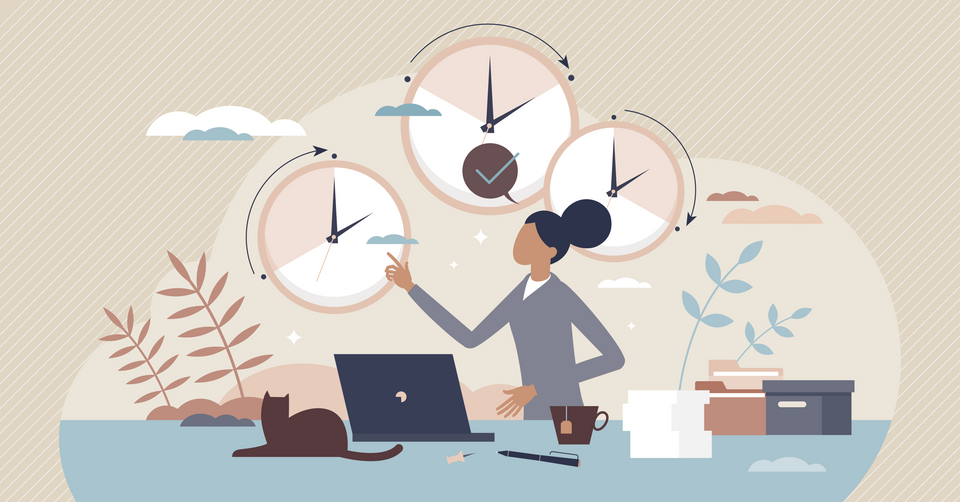
Introduction
In today's fast-paced world, busy professionals are constantly searching for ways to maximize productivity and efficiency. One area where time-saving opportunities often go unnoticed is during meetings. By implementing time-saving meeting hacks, you can transform unproductive gatherings into valuable and efficient sessions that yield tangible results. In this article, we'll explore various strategies and techniques for optimizing meeting efficiency, from embracing technology to fostering a productivity-centered meeting culture. Let's dive in and discover how you can make the most of your meetings and ultimately save time for your busy schedule.
The Importance of Meeting Preparation
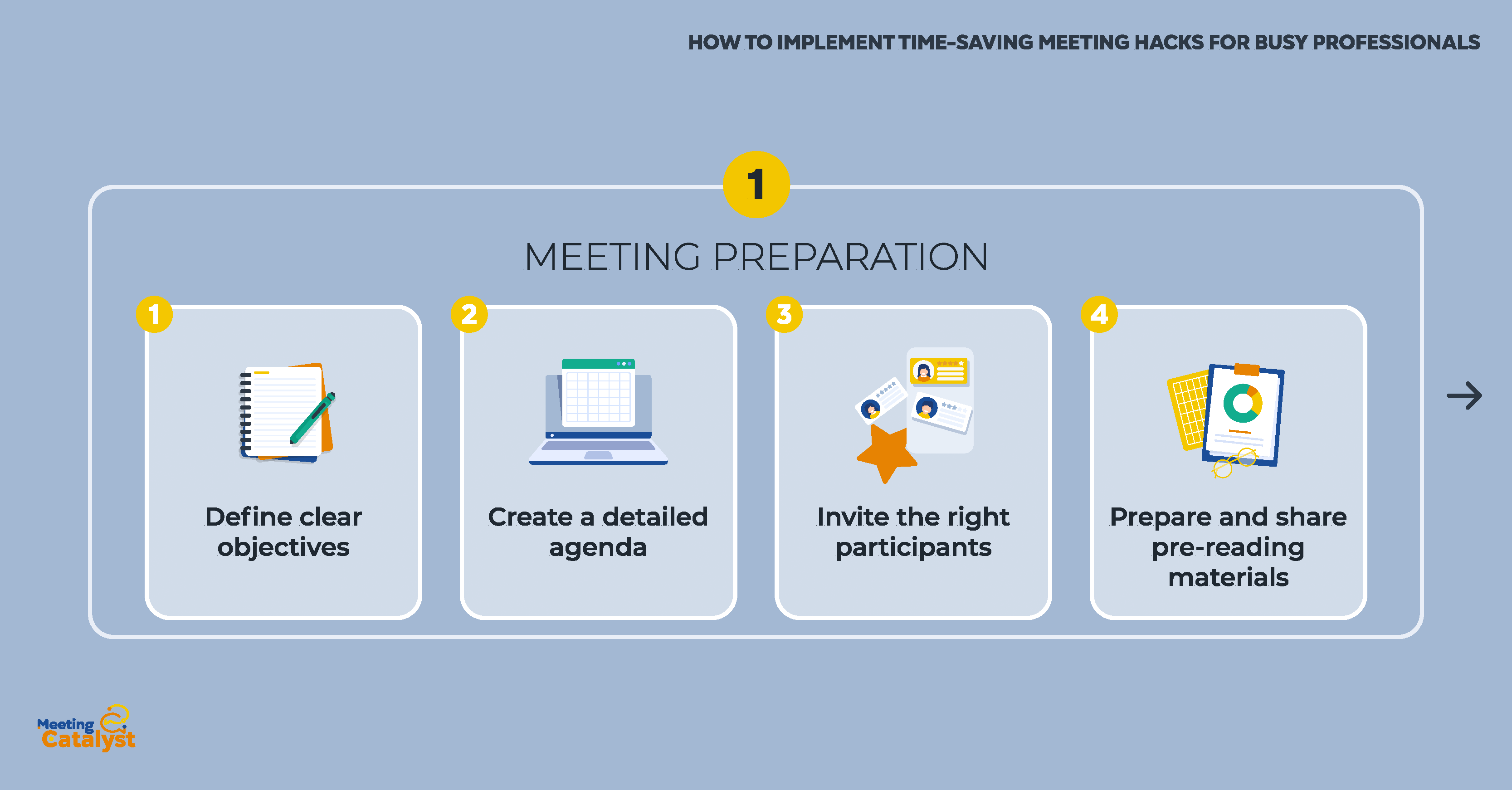
Proper preparation is the foundation of any successful meeting. By investing time and effort upfront, you can set the stage for a smooth and efficient gathering that respects everyone's time. In this section, we'll explore several key aspects of meeting preparation that can significantly impact the overall effectiveness and productivity of your meetings.
Define clear objectives: Start by establishing the primary goals and desired outcomes for the meeting. This clarity will help maintain focus and ensure that all attendees understand the purpose of the gathering.
Create a detailed agenda: A well-structured agenda acts as a roadmap for your meeting, outlining the topics to be covered and the time allocated for each. Be sure to distribute the agenda in advance, giving participants ample time to familiarize themselves with the material and come prepared with relevant questions or input.
Invite the right participants: Carefully consider who should attend the meeting to achieve the desired outcomes. Including only essential stakeholders helps prevent unnecessary distractions and streamlines decision-making processes.
Prepare and share pre-reading materials: Providing relevant materials ahead of the meeting allows participants to arrive well-informed and ready to engage in meaningful discussions. This proactive approach can help minimize time spent on basic explanations and context-setting during the meeting itself.
By prioritizing thorough meeting preparation, you can pave the way for a more focused, efficient, and fruitful gathering that respects the time constraints of busy professionals.
Embracing Technology for Streamlined Meetings
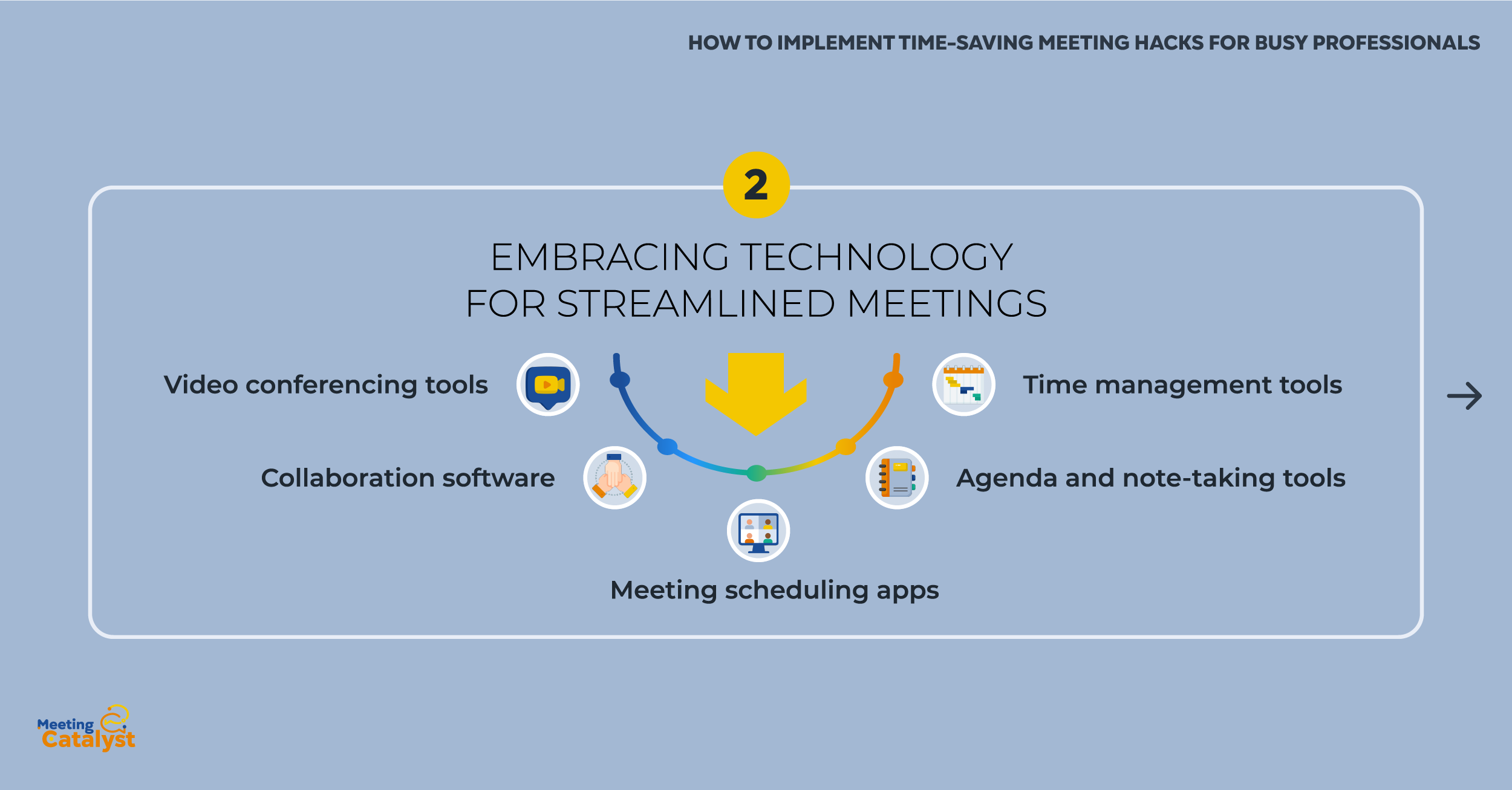
Leveraging technology can play a pivotal role in streamlining meetings and maximizing efficiency. By incorporating the right tools and platforms, you can save time, boost collaboration, and simplify the overall meeting experience. In this section, we'll explore several ways technology can help enhance your meetings and create time-saving opportunities for busy professionals.
Video conferencing tools: Utilize platforms like Zoom, Microsoft Teams, or Google Meet to facilitate remote meetings, saving time on commuting and enabling attendees to join from anywhere.
Collaboration software: Tools like Slack or Asana can help teams stay connected, share updates, and collaborate on tasks in real-time, reducing the need for lengthy status update meetings.
Meeting scheduling apps: Use scheduling apps like Doodle or Calendly to streamline the process of finding mutually available times for meetings, eliminating back-and-forth communication.
Agenda and note-taking tools: Apps like Notion or Evernote can help you create, share, and collaborate on agendas, meeting notes, and action items, keeping everyone on the same page and improving overall organization.
Time management tools: Implement time-tracking apps like Toggl or Time Doctor to monitor meeting durations and identify areas for improvement. Consider using time-boxing techniques or countdown timers to keep meetings on track and prevent them from running over.
By embracing technology and incorporating the right tools, you can create a more streamlined and efficient meeting experience that caters to the needs of busy professionals. Make sure to explore different options and find the solutions that best suit your team's unique requirements.
Mastering Time Management in Meetings
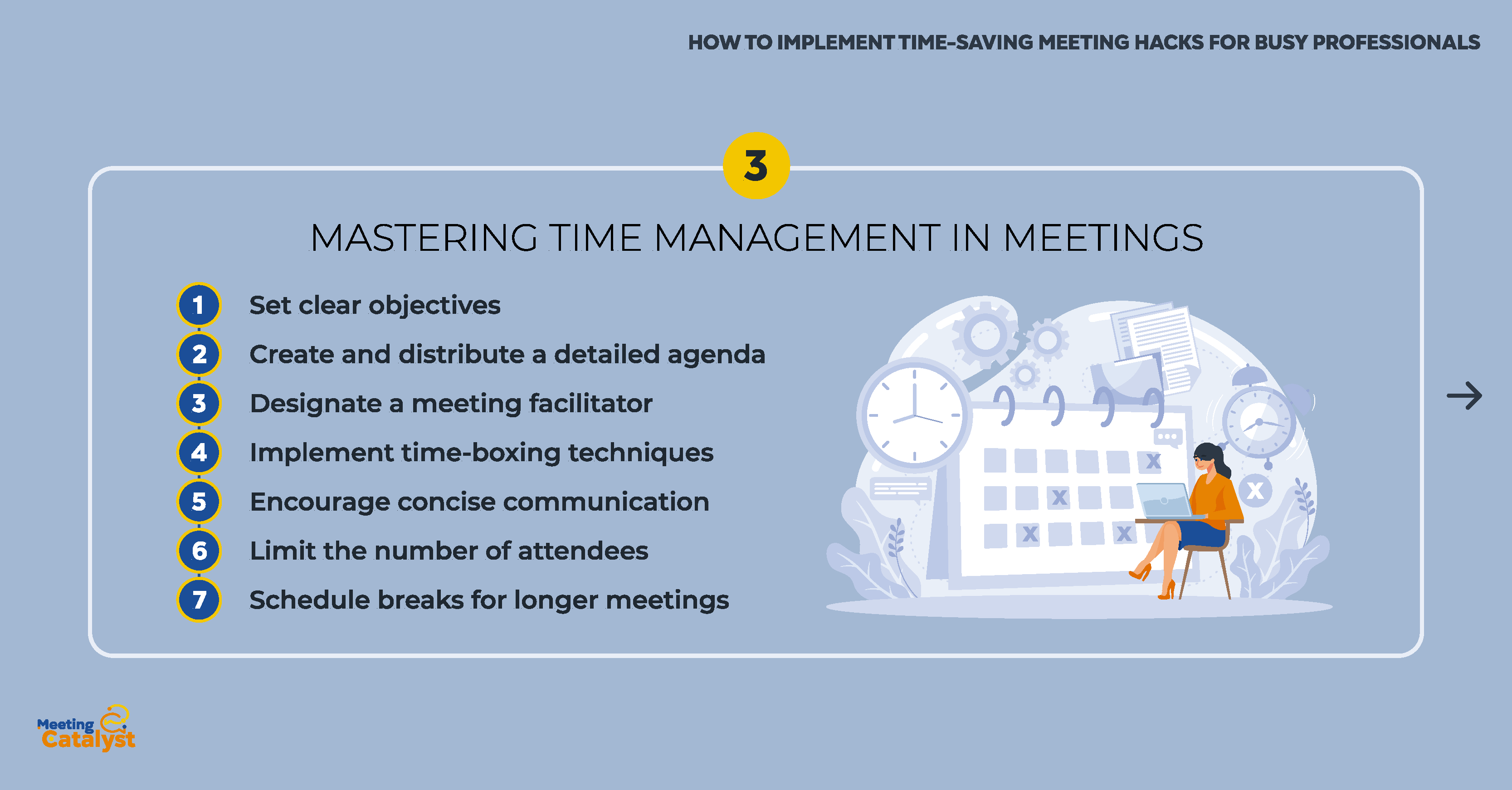
Effective time management in meetings is crucial for maintaining productivity and ensuring that valuable time isn't wasted. By incorporating strategies to maximize efficiency, you can create a more focused and results-driven meeting experience. In this section, we'll discuss various techniques to help you master time management in meetings and cater to the busy schedules of professionals.
Set clear objectives: Establish a clear purpose and desired outcomes for each meeting. This allows attendees to focus on achieving specific goals and minimizes the risk of veering off-topic.
Create and distribute a detailed agenda: Draft a comprehensive agenda that includes discussion points, time allocations, and responsible parties. Share this agenda with attendees in advance, allowing them to come prepared and stay on track during the meeting.
Designate a meeting facilitator: Assign a facilitator to guide the conversation, manage time, and ensure that agenda items are covered within the allotted timeframe. This person can also intervene when discussions veer off-topic or become unproductive.
Implement time-boxing techniques: Allocate specific time slots for each agenda item, and stick to them. Time-boxing can help maintain focus and prevent meetings from dragging on unnecessarily.
Encourage concise communication: Promote a culture of brevity and directness in meetings. Encourage attendees to be succinct and to the point, reducing the likelihood of lengthy and meandering discussions.
Limit the number of attendees: Only invite individuals who are essential to the meeting's purpose. Smaller groups are often more efficient and can make decisions more quickly.
Schedule breaks for longer meetings: Plan brief breaks during extended meetings to prevent fatigue and maintain focus. This also provides an opportunity for informal discussions and networking.
By mastering time management techniques and implementing these strategies in your meetings, you can create a more efficient and productive environment that respects the busy schedules of professionals.
Implementing Efficient Meeting Formats
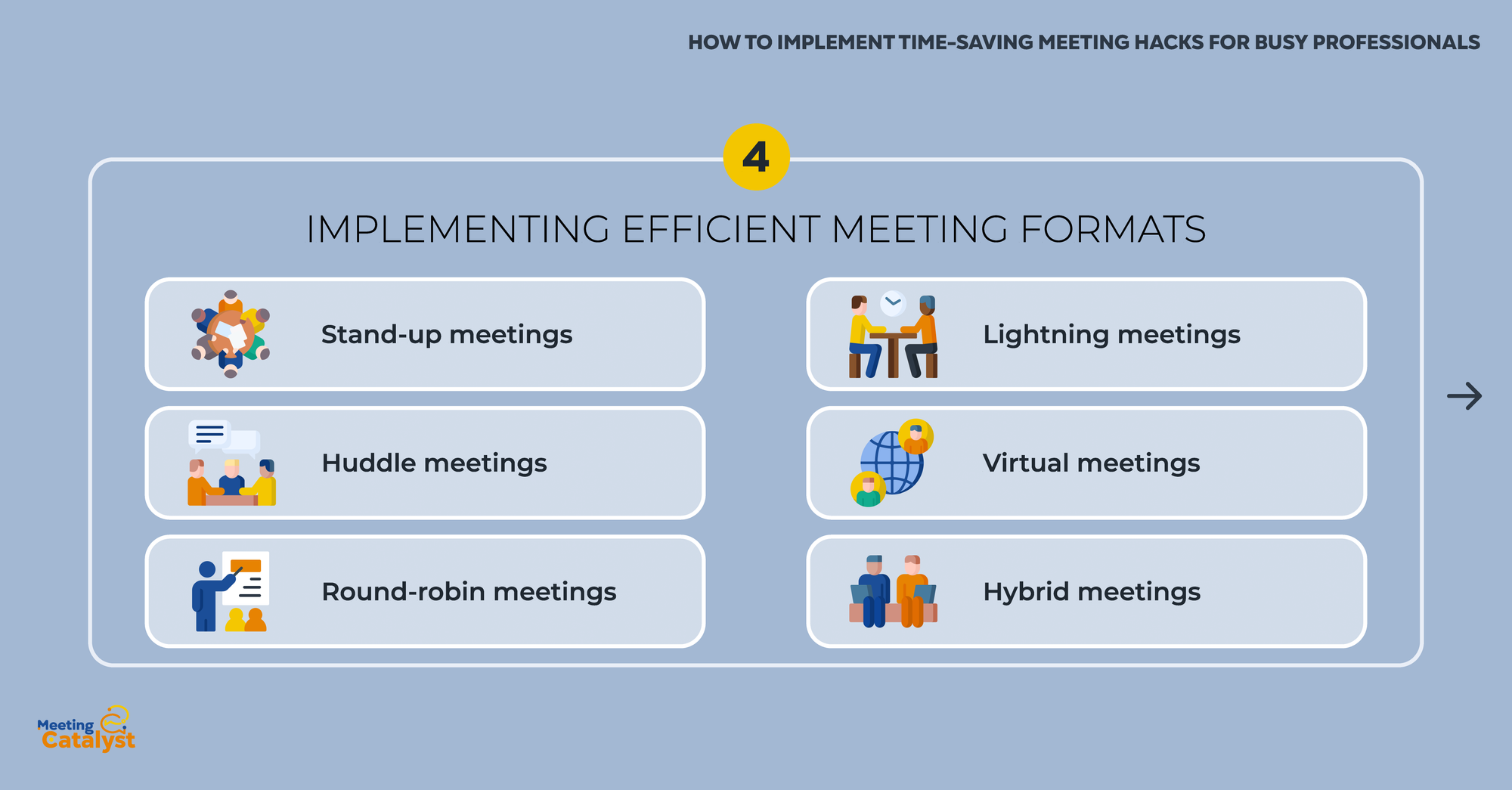
Different meeting formats can have a significant impact on the overall efficiency and productivity of your meetings. Choosing the right format can help streamline the meeting process, making it easier for busy professionals to get the most out of their time. In this section, we'll explore various meeting formats that can save time and enhance productivity.
Stand-up meetings: These short, focused meetings typically last no more than 15-20 minutes and require participants to stand. The standing format encourages brevity and keeps discussions on point.
Huddle meetings: Huddle meetings are quick, informal gatherings that take place at the beginning or end of a workday. They are designed to share updates, address urgent issues, and set priorities for the day or week ahead.
Round-robin meetings: In this format, each attendee is given a specific amount of time to share updates or contribute to the discussion. This ensures that everyone has a chance to speak while maintaining a structured timeframe.
Lightning meetings: These are short, rapid-fire meetings designed to address a single issue or make a quick decision. Lightning meetings should be focused and limited to only essential participants.
Virtual meetings: Utilizing video conferencing tools can save time by eliminating the need for travel and accommodating remote team members. Ensure that virtual meetings are well-structured and have a clear agenda to maintain focus and efficiency.
Hybrid meetings: A combination of in-person and virtual attendance, hybrid meetings offer flexibility for participants who may not be able to physically attend. This format also helps to reduce travel time and accommodate busy schedules.
By experimenting with different meeting formats and identifying which ones work best for your team, you can improve meeting efficiency and save time for busy professionals. Remember to adapt your meeting format to the specific needs of your team and the objectives of each meeting.
Cultivating a Meeting Culture Focused on Productivity
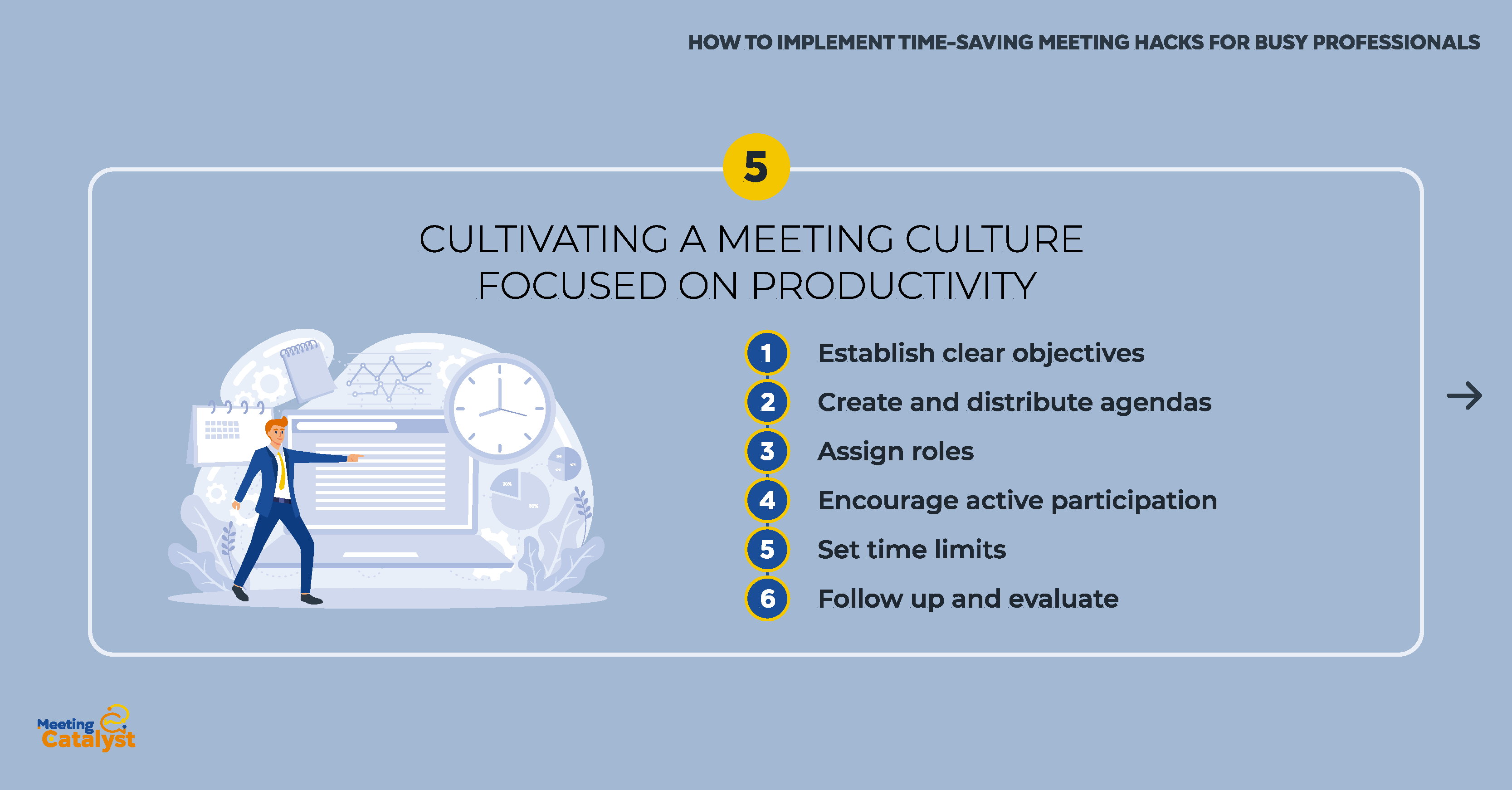
A meeting culture that prioritizes productivity is essential for busy professionals who want to maximize the effectiveness of their time spent in meetings. By promoting a culture of efficiency and accountability, you can ensure that meetings are valuable and results-driven. Here are some tips for cultivating a productivity-focused meeting culture:
Establish clear objectives: Ensure that every meeting has a defined purpose and specific goals. Clearly communicate these objectives to attendees before the meeting, so they come prepared to contribute effectively.
Create and distribute agendas: Develop a detailed agenda outlining the topics to be covered, the time allocated for each item, and the expected outcome. Share the agenda with participants in advance, allowing them to prepare and gather any necessary materials.
Assign roles: Assign specific roles to meeting participants, such as a facilitator, timekeeper, and note-taker. This helps ensure that meetings stay on track and that everyone is engaged and accountable.
Encourage active participation: Create an environment where everyone feels comfortable sharing ideas and opinions. Encourage team members to ask questions and challenge assumptions to foster a culture of open communication and critical thinking.
Set time limits: Establish strict time limits for meetings and adhere to them. This helps maintain focus and prevents meetings from dragging on unnecessarily.
Follow up and evaluate: After each meeting, distribute meeting notes and action items to attendees. Assess the meeting's effectiveness and identify any areas for improvement. This continuous evaluation process will help refine your meeting strategies over time.
By actively working to cultivate a meeting culture focused on productivity, you can ensure that meetings are efficient and valuable, ultimately saving time for busy professionals.
Minimizing Distractions and Maintaining Focus
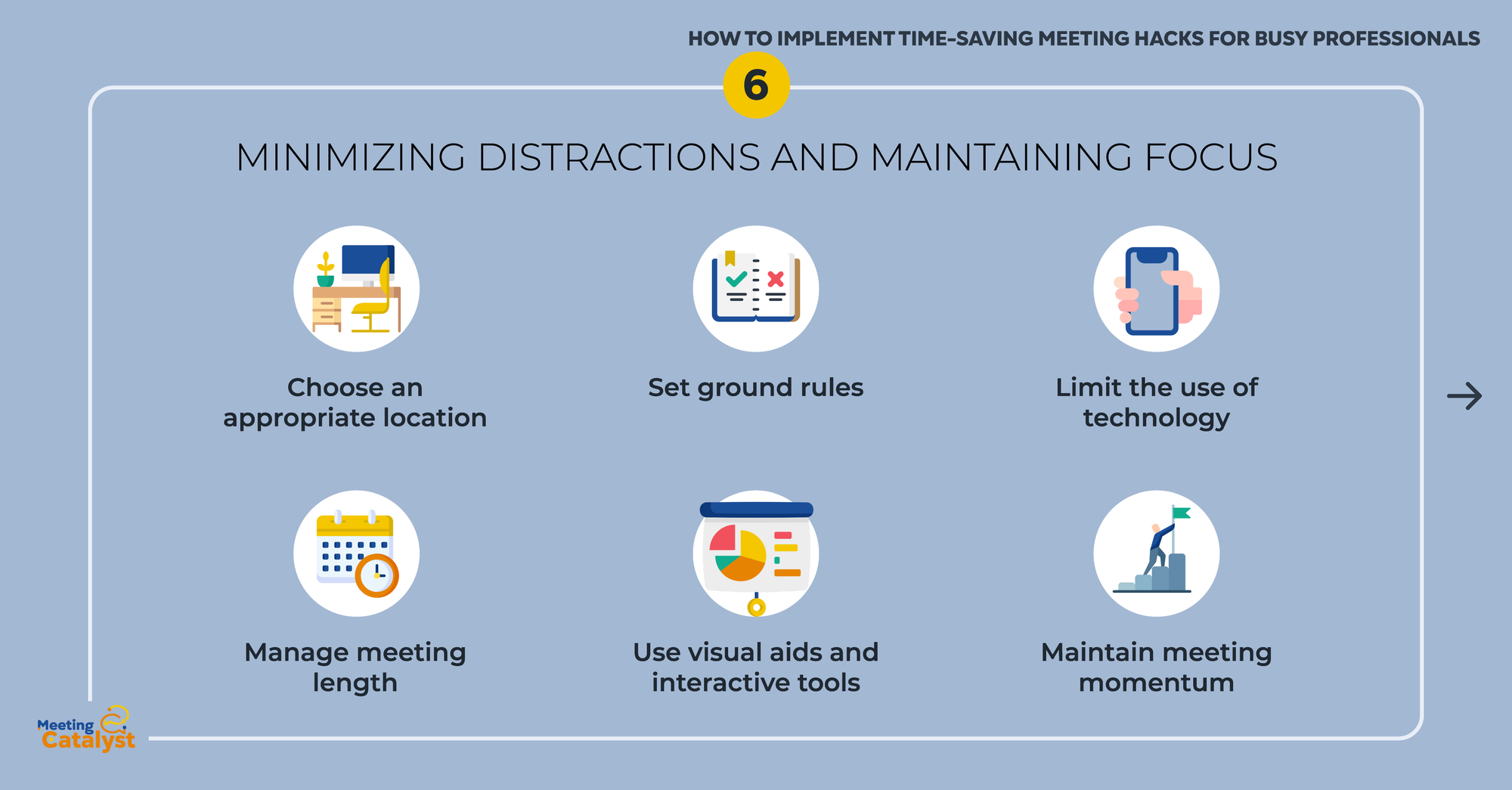
Minimizing distractions and maintaining focus during meetings is crucial for busy professionals who want to make the most of their time. By reducing interruptions and promoting an atmosphere of concentration, you can significantly increase the efficiency of your meetings. Here are some strategies for minimizing distractions and maintaining focus:
Choose an appropriate location: Select a quiet, comfortable meeting space that is free from external noise and disruptions. Ensure that the room has adequate lighting and seating to facilitate focus and productivity.
Set ground rules: Establish clear expectations for meeting conduct, such as turning off cell phones, avoiding side conversations, and respecting others' speaking time. This will help create an environment that fosters focus and engagement.
Limit the use of technology: While technology can be a powerful tool for facilitating meetings, it can also be a source of distraction. Encourage participants to use devices only when necessary for the meeting and discourage unnecessary multitasking.
Manage meeting length: Keep meetings as short as possible to maintain focus and prevent fatigue. Break longer meetings into shorter segments with breaks in between to allow participants to recharge and refocus.
Use visual aids and interactive tools: Utilize visual aids, such as presentations, whiteboards, or flip charts, to help maintain attendees' attention. Incorporate interactive elements, like group activities or brainstorming sessions, to keep participants engaged and focused.
Maintain meeting momentum: Ensure that discussions stay on track and progress at a steady pace. The facilitator should monitor the conversation, redirecting it when necessary and moving on to the next topic when appropriate.
By implementing these strategies, you can minimize distractions and maintain focus during meetings, ensuring that time is used effectively and productively. This will ultimately save time for busy professionals and contribute to a more efficient meeting culture.
Assessing and Improving Meeting Efficiency
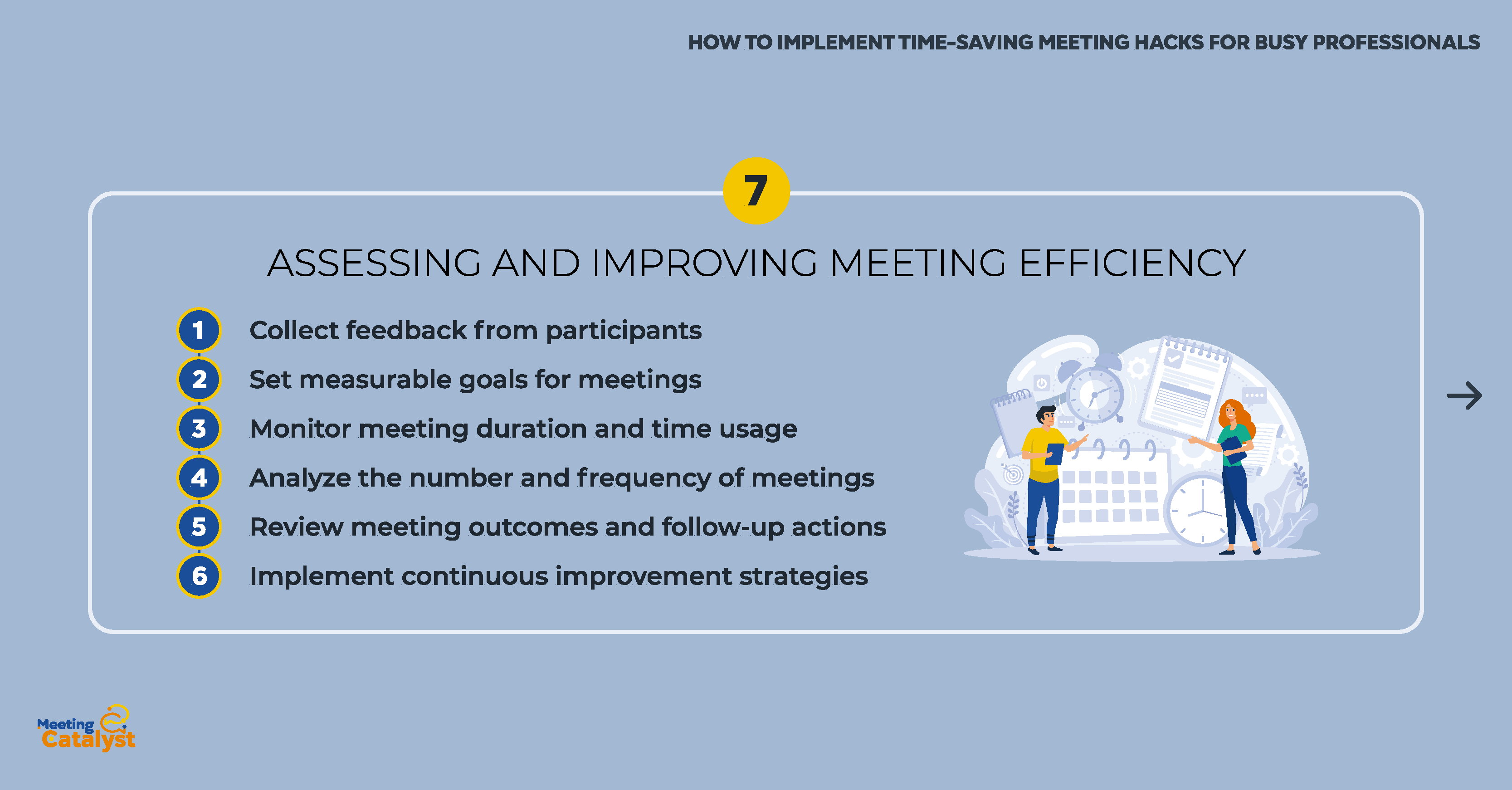
To ensure that your time-saving meeting hacks are effective, it's essential to assess and continuously improve meeting efficiency. Regular evaluation of your meeting processes will help identify areas for improvement and ensure that your meetings remain productive and focused. Here are some methods for assessing and improving meeting efficiency:
Collect feedback from participants: After each meeting, ask attendees for their feedback on the effectiveness of the meeting. This can be done through anonymous surveys or direct communication, depending on your organization's culture. Use the feedback to identify areas for improvement and adjust your meeting processes accordingly.
Set measurable goals for meetings: Establish specific, quantifiable objectives for each meeting, and evaluate whether these goals have been met at the conclusion of the meeting. This will help you determine if the meeting was successful and if any adjustments need to be made for future meetings.
Monitor meeting duration and time usage: Keep track of the length of your meetings and the time spent on each agenda item. If meetings consistently run over the allotted time or certain topics consume too much time, consider adjusting the agenda or implementing time-saving strategies.
Analyze the number and frequency of meetings: Evaluate whether the number of meetings your team holds is necessary and efficient. If you find that meetings are held too frequently or are redundant, consider reducing the number of meetings or combining them to save time.
Review meeting outcomes and follow-up actions: Assess the outcomes of your meetings and the progress made on follow-up actions. If meetings regularly fail to produce tangible results or follow-up actions are not completed, you may need to revise your meeting processes to ensure they are more effective.
Implement continuous improvement strategies: Regularly review and update your meeting processes based on feedback, data analysis, and best practices. Continuous improvement will help ensure that your meetings remain efficient and productive.
By assessing and improving meeting efficiency, you can optimize the effectiveness of your time-saving meeting hacks and ensure that your team's meetings are productive and focused. This will ultimately save time for busy professionals and contribute to a more efficient meeting culture.
Knowing When to Skip a Meeting
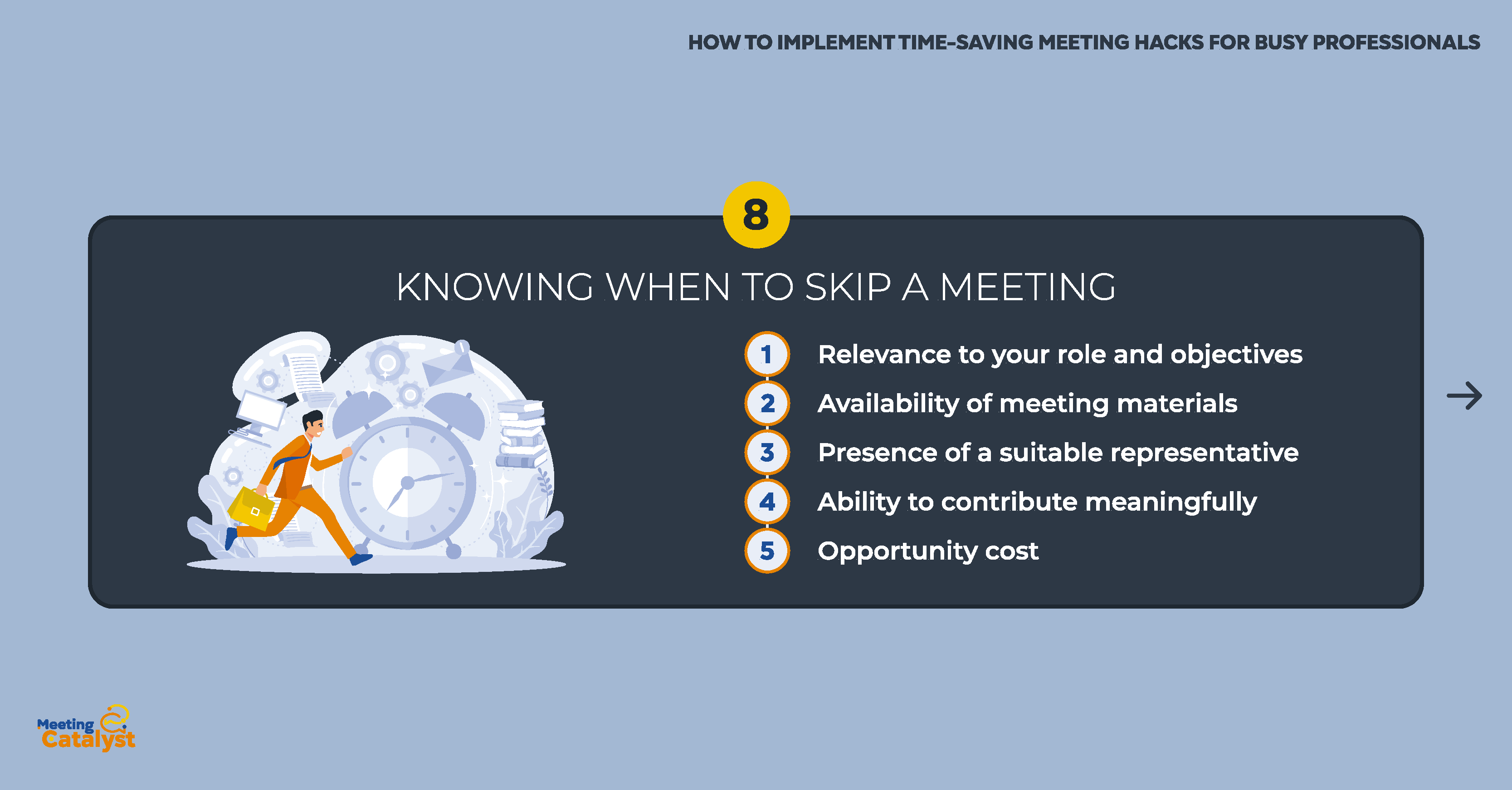
One of the most effective time-saving meeting hacks for busy professionals is knowing when to skip a meeting altogether. While it may seem counterintuitive, sometimes not attending a meeting can save time and increase overall productivity. Here are some factors to consider when deciding whether or not to attend a meeting:
Relevance to your role and objectives: Evaluate the meeting agenda and determine if the topics discussed are directly relevant to your role and objectives. If the meeting does not align with your priorities or does not require your expertise, it may be more efficient to skip the meeting and focus on other tasks.
Availability of meeting materials: If a meeting's agenda and materials are accessible before or after the meeting, you may not need to attend in person. Instead, review the materials at your convenience, and if necessary, follow up with specific questions or concerns.
Presence of a suitable representative: If someone else on your team can attend the meeting in your place and effectively represent your perspective, consider delegating attendance to them. This will allow you to focus on other tasks while still ensuring that your input is considered.
Ability to contribute meaningfully: Assess whether your presence at the meeting would provide meaningful contributions to the discussion. If you believe that your input would not significantly impact the outcome, it may be more efficient to skip the meeting.
Opportunity cost: Consider the opportunity cost of attending the meeting. If your time could be better spent on other tasks that have a greater impact on your productivity and goals, it may be more beneficial to skip the meeting and focus on those tasks instead.
By carefully evaluating whether or not to attend a meeting, you can make more efficient use of your time and ensure that you are focusing your efforts on tasks that align with your priorities and objectives. Knowing when to skip a meeting is a valuable time-saving hack for busy professionals seeking to maximize their productivity.
Conclusion
Time is a valuable resource for busy professionals, and implementing time-saving meeting hacks is essential for maximizing productivity and effectiveness in the workplace. By prioritizing meeting preparation, embracing technology, mastering time management, exploring efficient meeting formats, cultivating a productivity-focused meeting culture, minimizing distractions, assessing and improving meeting efficiency, and knowing when to skip a meeting, you can make the most of your time and ensure that meetings are a valuable component of your workday.
By adopting these strategies, you'll not only optimize your own efficiency, but also contribute to a more productive and successful work environment for your entire team. Remember, it's not just about the number of meetings you attend, but the quality and effectiveness of those meetings that will truly make a difference. Invest in these time-saving meeting hacks, and you'll see a positive impact on your professional life and your organization as a whole.